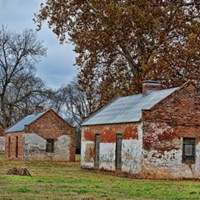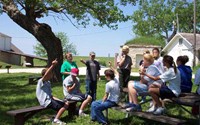- Lesson Plan (95)
- Field Trips (27)
- Student Activities (12)
- Distance Learning (8)
- Teacher Reference Materials (4)
- Other Education Materials (2)
- Primary Sources (2)
- Traveling Trunk (2)
- Field Schools & Institutes (1)
- Media for Loan (1)
- Science Labs (1)
- Acadia National Park (8)
- Glacier National Park (8)
- Florissant Fossil Beds National Monument (6)
- Hawaiʻi Volcanoes National Park (5)
- Olympic National Park (5)
- Bent's Old Fort National Historic Site (4)
- Dayton Aviation Heritage National Historical Park (4)
- Ellis Island Part of Statue of Liberty National Monument (4)
- Hopewell Culture National Historical Park (4)
- Show More ...
- Science (108)
- Social Studies (64)
- Literacy and Language Arts (37)
- Math (20)
Showing 151 results for scientific process ...
The Scientific Method
Scientific Discovery Trunk 3rd-5th Grade
- Type: Traveling Trunk
- Grade Levels: Upper Elementary: Third Grade through Fifth Grade
Scientific Discovery Trunk 6th-8th Grade
- Type: Traveling Trunk
- Grade Levels: Middle School: Sixth Grade through Eighth Grade

This trunk includes exhibit and modern scientific equipment, a resource guide, books, posters and more. It offers students an opportunity to learn about the natural scientific observations from the Lewis and Clark Expedition and the impacts of the changes which have occurred over the past 200 years.
Create an Animal: A Teacher's Guide to Scientific Classification
Dam Removal: A long and difficult process
- Type: Student Activities
- Grade Levels: Middle School: Sixth Grade through Eighth Grade
Horse Teeth and Diet
- Type: Lesson Plan
- Grade Levels: Upper Elementary: Third Grade through Fifth Grade

In this lesson plan, students will use the scientific method to learn about horses' diets from 3d replicas of horse teeth found on Assateague Island. The 3d replicas are viewable online, or the files may be downloaded and 3d printed. In the process, students will learn an archeological method for learning about animals' lives in the past.
Death Traps
- Type: Teacher Reference Materials
- Grade Levels: Middle School: Sixth Grade through Eighth Grade

This scripted slideshow for teachers describes the process by which animals have died and become fossilized in waterholes, influenced by a severe drought. It compares two sites, separated by 13 million years: Agate Fossil Beds and the Badlands. It is designed to teach students the principles relating to the behavior, habitat and survival of living animals; as well as scientific study of past life forms known as fossils; and severe climatic events.
Environmental Prairie Science
Science on the Prairie
Seeing Into the Ground: Archeology and Magnetometry
- Type: Lesson Plan
- Grade Levels: High School: Ninth Grade through Twelfth Grade

Learn how archeologists use geophysical techniques like magnetometry to learn more about ancient objects and people. Explore the scientific process behind magnetometry, including magnetic fields, and how archeologists interpret their results. Complete a simulated magnetometry analysis using data from Knife River Indian Villages National Historic Site. Este plan de clase con actividades incluido también está disponible en español.
Make Your Own Barometer
- Type: Student Activities
- Grade Levels: Upper Elementary: Third Grade through Fifth Grade
Students will learn about the scientific instrument called a barometer. They will be able to create their own barometer at home and record atmospheric pressure data.
What Did They Eat?: Archeology and Animal Bones
- Type: Lesson Plan
- Grade Levels: Middle School: Sixth Grade through Eighth Grade

This lesson illustrates how archaeologists use faunal analysis, or the study of animal bones, to explore what people in the past ate and how they obtained their food. By applying concepts of taxonomy and scientific classification, it demonstrates how archaeologists use both scientific methods and historical research to interpret past lifeways. Este plan de clase con actividades incluido también está disponible en español.
Introduction to Citizen Science
- Type: Lesson Plan
- Grade Levels: Middle School: Sixth Grade through Eighth Grade

Citizen Science is the involvement of everyday people in making scientific observations of the world around us. These observations address real world problems and contribute to scientific research projects. Citizen Science initiatives provide opportunities for the public to collect data in the field and report findings to databases used by professional scientists. Introduce your students to this growing field, in which amateur scientists can contribute meaningful observations to science.
Geology
Lahar in a Jar
Weather Wonders
- Type: Lesson Plan
- Grade Levels: Upper Elementary: Third Grade through Fifth Grade
How Many Salmon Are Enough?
- Type: Lesson Plan
- Grade Levels: High School: Ninth Grade through Twelfth Grade













